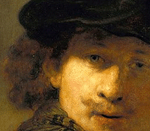
"Joseph Presenting His Father and his Brothers to the Pharaoh"
The Bible (Genesis 47: 1-10) recounts the moment that Joseph introduces his brothers and aged father to Pharaoh. Having arrived in Egypt after fleeing famine in Canaan, his brothers joined Joseph in Goshen seeking fertile pasture land for their flocks. 'Pharaoh said to Joseph, "Your father and your brothers have come to you, and the land of Egypt is before you; settle your father and your brothers in the best part of the land. Let them live in Goshen."' Then Joseph presented his father before Pharaoh. 'After Jacob blessed Pharaoh, Pharaoh asked him, "How old are you?" And Jacob said to pharaoh, "The years of my pilgrimage are a hundred and thirty."' Boucher’s painting depicts the seated and crowned Egyptian Pharaoh reaching out his hand to welcome the elderly, bearded Jacob, who is being introduced by the youthful, turbaned Joseph who stands between them; the brothers and their wives witness the meeting, their calling as herdsman indicated by their staffs.
Possibly the most popular 18th century artist, Francois Boucher was a French painter in the Rococo style. . After three years of work and artistic study, Boucher won the Grand Prix de Rome, a scholarship for artistic study, allowing him to travel to Italy and further his study in art. Upon his return to France, he was accepted into the Royal Academy of Painting and Sculpture, and three years later became a faculty member.
His painting career accelerated rapidly, and he was promoted to the Rector of the Academy, then head of the Royal Gobelins Manufacturing Company, and later First Painter to the King, Louis XV. His most prominent supporterduring his stay at the court, indeed in his entire career, was Madame de Pompadour, the mistress to King Louis XV, of whom he painted several portraits.
Many of his paintings depicted idyllic pastoral scenes or classical historical paintings, but his more risqué odalisque paintings in his later career led to many attacks on his moral character. Nevertheless, his paintings and artistic style was always in demand, and in addition to paintings he created theater costumes and sets, tapestries, and decorations for court celebrations. His work was prominent that it was reproduced in engravings and on porcelain and biscuit-ware. By the time of his death, Francois Boucher’s name and body of work had become synonymous with the Rococo style.
Boucher is also famous for his saying: "La nature est trop verte et mal éclairée" (The nature is too green and badly lit).